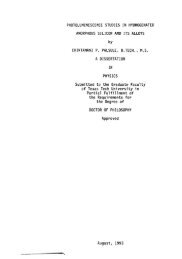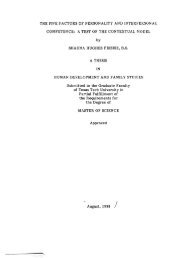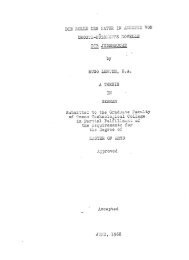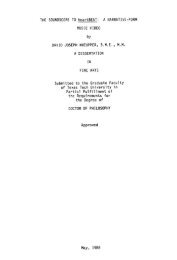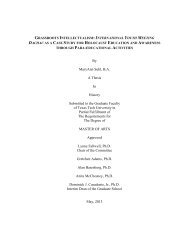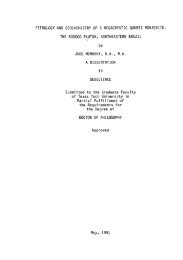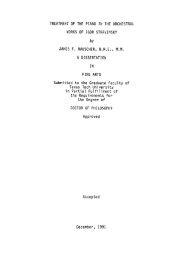- Page 1 and 2: OVERUSE INJURIES AND PIANO TECHNIQU
- Page 3 and 4: ACKNOWLEDGEMENTS I would like to ex
- Page 5 and 6: III. BIOMECHANICAL DESCRffTIONS OF
- Page 7 and 8: ABSTRACT Of the total number of mus
- Page 9 and 10: LIST OF TABLES 3.1 Extrinsic Muscle
- Page 11 and 12: 4.6 Thoracic Outlet Syndrome 199 4.
- Page 13 and 14: Fingers."! Laires, a student of Phi
- Page 15 and 16: The motions used in piano playing a
- Page 17 and 18: tendons and joints during piano pla
- Page 19 and 20: keyboards and acoustic grands. Thou
- Page 21: male pianists ranging in age from 1
- Page 25 and 26: determine how the wrist was being u
- Page 27 and 28: which the hammer of the piano mecha
- Page 29 and 30: least for practice if not for publi
- Page 31 and 32: processes leading into a given cycl
- Page 33 and 34: execution of a technical skill at t
- Page 35 and 36: CHAPTER II TWENTIETH-CENTURY PEDAG
- Page 37 and 38: finger motions. The finger muscles
- Page 39 and 40: that the player poise the hands abo
- Page 41 and 42: is only a successfully musical play
- Page 43 and 44: strong flexors, there is a momentar
- Page 45 and 46: Matthay declared that there is no s
- Page 47 and 48: exclusively to one of the three cat
- Page 49 and 50: potential to generate excessive ten
- Page 51 and 52: inappropriate. Pichier claimed that
- Page 53 and 54: fingers. She addressed the role of
- Page 55 and 56: described in great detail the skele
- Page 57 and 58: otation of the upper arm. The finge
- Page 59 and 60: a piece. He therefore asserted that
- Page 61 and 62: amount of resistance differs from k
- Page 63 and 64: and vertical movement at the keyboa
- Page 65 and 66: problem in repertoire which is rela
- Page 67 and 68: way to develop physical technical c
- Page 69 and 70: interference. Contextual interferen
- Page 71 and 72: "-^ '"(«>1" iiH^'*^"^-J J^"t o)
- Page 73 and 74:
Gyorgy Sandor claimed that practici
- Page 75 and 76:
the relative strength of the finger
- Page 77 and 78:
ability to independently extend the
- Page 79 and 80:
of variation. If control of the mov
- Page 81 and 82:
muscle and tendon structure and fun
- Page 83 and 84:
the observations wiU be broad enoug
- Page 85 and 86:
Acromion process Long bead ofbi Tic
- Page 87 and 88:
extension fi»:Cri Utfrrif totabon
- Page 89 and 90:
stabiUty and greater freedom of mov
- Page 91 and 92:
This muscle contributes most to elb
- Page 93 and 94:
Radius Figure 3.4. Pronator Quadrat
- Page 95 and 96:
outside lower end of the humems and
- Page 97 and 98:
flexion are located on the anterior
- Page 99 and 100:
Figure 3.7. Joints of the Fingers 8
- Page 101 and 102:
Flexion Extension Abduction Adducti
- Page 103 and 104:
Table 3.1. Major Extrinsic Muscles
- Page 105 and 106:
Therefore, some of the motions whic
- Page 107 and 108:
accomplished by a lateral shifting
- Page 109 and 110:
that both elbow extension and humer
- Page 111 and 112:
After this exerdse is mastered, the
- Page 113 and 114:
scale, and the upper arm and elbow
- Page 115 and 116:
should be the last technical skiU t
- Page 117 and 118:
motion of the thumb is exceeded if
- Page 119 and 120:
In summary, the thumb and the cross
- Page 121 and 122:
The goal in scale playing is a smoo
- Page 123 and 124:
continue to the next odave of the s
- Page 125 and 126:
the hands are lifted from the lap a
- Page 127 and 128:
gravity begins a shift back to the
- Page 129 and 130:
hand, and are generally higher duri
- Page 131 and 132:
analyzing movements instead of conc
- Page 133 and 134:
in position will result in slight b
- Page 135 and 136:
esponsible for initiating movement.
- Page 137 and 138:
Rapid exerdses which require a quie
- Page 139 and 140:
independently from the hand and arm
- Page 141 and 142:
land on its key. In rapid arpeggios
- Page 143 and 144:
hand coUapses somewhat, giving grea
- Page 145 and 146:
the hand is in its neutral aUgnment
- Page 147 and 148:
acceleration and velocity are not t
- Page 149 and 150:
conunonly used 2-3 fingering.! 5! U
- Page 151 and 152:
level at which the tone is produced
- Page 153 and 154:
is conceivable that the process wou
- Page 155 and 156:
finger. However, if the thumb is ex
- Page 157 and 158:
playing, it is a question of which
- Page 159 and 160:
of chromatic-double-note passages.!
- Page 161 and 162:
esuh in a "kind of diagonal pull" a
- Page 163 and 164:
does not tine up behind the second
- Page 165 and 166:
Last has acknowledged that hand siz
- Page 167 and 168:
tightens vmst adion, necessitating
- Page 169 and 170:
onto the appropriate keys. As inten
- Page 171 and 172:
This rebounding effect is fadtitate
- Page 173 and 174:
Biomechanical Description of Double
- Page 175 and 176:
Octave Scales Odave scales are usua
- Page 177 and 178:
to the demands of the task anyway)
- Page 179 and 180:
wrist in the frontal plane. Newman
- Page 181 and 182:
"unfolding" fingers.228 pink pointe
- Page 183 and 184:
moment of key impad, the joints of
- Page 185 and 186:
CFL\PTER rV PREVENTION OF KEYBOARD
- Page 187 and 188:
Motions made at the piano are not m
- Page 189 and 190:
Force Charaderistics Mechanical cha
- Page 191 and 192:
equire more than a single stimulus
- Page 193 and 194:
area. It is also possible that stre
- Page 195 and 196:
waste products, resulting in increa
- Page 197 and 198:
12 Apphed 10 Stress (N/mm2) 8 0 'To
- Page 199 and 200:
does not take place instantaneously
- Page 201 and 202:
these injuries may be theoreticaUy
- Page 203 and 204:
termed "tenosynovitis." If the teno
- Page 205 and 206:
Figure 4.3. 'Trigger" Finger TRIGGE
- Page 207 and 208:
Ulnar Nerve Transverse Carpal Ligam
- Page 209 and 210:
Ulnar Nerve Cubital Tunnel Rexor Ca
- Page 211 and 212:
tingling and pain along the ulnar s
- Page 213 and 214:
treatment. Conservative measures, s
- Page 215 and 216:
Performing Artists in Chicago, reco
- Page 217 and 218:
joints and the transverse axis thro
- Page 219 and 220:
Observations Regarding the Entire P
- Page 221 and 222:
typists) this recommendation might
- Page 223 and 224:
fingers are required to produce the
- Page 225 and 226:
playmg.106 He did claim, however, t
- Page 227 and 228:
(sti-aight) or sUghtly drooped betw
- Page 229 and 230:
more overuse injuries are reported
- Page 231 and 232:
and isolated segment of the "work c
- Page 233 and 234:
sudden exposure to temperatures bel
- Page 235 and 236:
of key at rest and the point at whi
- Page 237 and 238:
Meuike generalized that the single
- Page 239 and 240:
epetition. The pianist can ameliora
- Page 241 and 242:
CHAPTER V CONCLUSION The Need For B
- Page 243 and 244:
strength in the fingers themselves.
- Page 245 and 246:
individual differences, all human b
- Page 247 and 248:
movement in all the involved planes
- Page 249 and 250:
quatitative analysis was developed
- Page 251 and 252:
III. C. What environmental factors
- Page 253 and 254:
Table 5.1 Continued Right Hand Asce
- Page 255 and 256:
Table 5.3. Checktist for Trills' MO
- Page 257 and 258:
Table 5.5. Checklist for Octave Sca
- Page 259 and 260:
inversion at a time. The goal is ev
- Page 261 and 262:
student's technique based upon thes
- Page 263 and 264:
fingers, may be defined. Quantified
- Page 265 and 266:
Chaffin, Don B. and Gunnar B.J. And
- Page 267 and 268:
KeUa, John J., Ph.D. "Musculoskelet
- Page 269 and 270:
Rempel, David. "Musculoskeletal Loa
- Page 271 and 272:
APPENDDC A GLOSSARY OF TERMS 260
- Page 273 and 274:
Deltoid-muscle of the glenohumeral
- Page 275 and 276:
Pennate-vdth regard to muscle fiber
- Page 277 and 278:
APPENDDC B ADDITIONAL ANATOMIC FIGU
- Page 279 and 280:
trtctips mMial epiconttyle olecrano
- Page 281 and 282:
^^_: y.. > i \->-" i ' • • p. )
- Page 283 and 284:
Sternal oectoralis maior Anterior d
- Page 285 and 286:
Muscle Fiber Types and Architecture
- Page 287 and 288:
move body segments through a greate
- Page 289 and 290:
about the normal length of a muscle
- Page 291:
provide lubrication, protection, an



